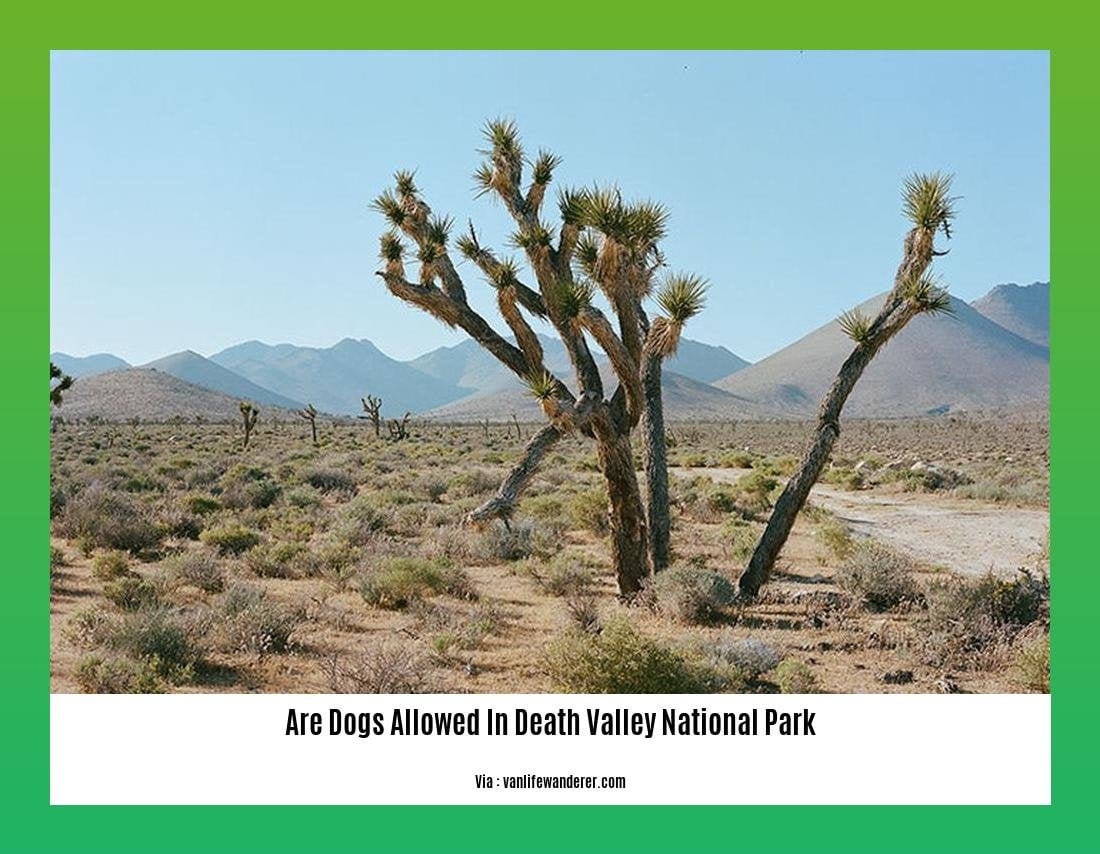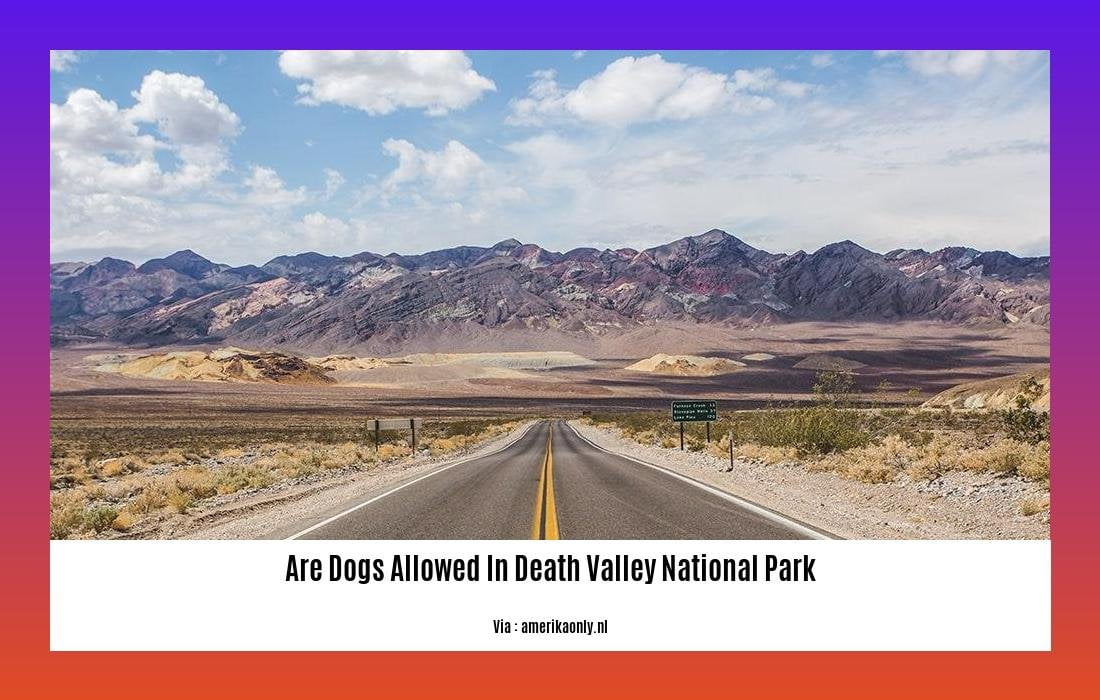Are dogs allowed in Death Valley National Park? Unveiling the pet policies and rules. If you’re an outdoor enthusiast and a proud pet parent, you may be wondering whether you can bring your furry companion along on your next adventure to Death Valley National Park. As an experienced travel writer with a passion for exploring national parks and uncovering pet-friendly destinations, I have delved into the rules and regulations surrounding pets in various park systems. In this article, I’ll provide you with insightful information on the pet policies and rules of Death Valley National Park, so you can determine whether your four-legged friend can join you in experiencing the captivating beauty of this desert park.
Key Takeaways:
- Dogs are allowed in Death Valley National Park, but there are restrictions in place.
- Dogs must be kept on a leash at all times and are not allowed on trails or in backcountry areas.
- Dogs are only allowed on paved and dirt roads, not on trails or inside park buildings.
- Summer temperatures in Death Valley can be extreme and potentially dangerous for pets.
- Pets are welcome in campgrounds, picnic areas, and developed areas of the park, but must be restrained or kept on a leash no longer than 6 feet.
- Leaving pets in a car during the day is not permitted in the park.
- Food and water should not be left unattended as it can attract coyotes and ravens.
- More information on the pet policy and rules in Death Valley National Park can be found on the National Park Service website.
Are Dogs Allowed in Death Valley National Park? Unveiling the Pet Policies and Rules

As an avid outdoor enthusiast and experienced travel writer, I understand the importance of finding pet-friendly destinations for our furry companions. If you’re planning a trip to Death Valley National Park with your four-legged friend, it’s essential to know the rules and regulations concerning pets in this captivating desert park. So, let’s dive into the pet policies and rules of Death Valley National Park to ensure a safe and enjoyable adventure for everyone involved.
Understanding the Pet Policies and Restrictions
According to Vet Advises, dogs are indeed allowed in Death Valley National Park, but there are some restrictions in place. To maintain the safety of park resources, wildlife, other visitors, and even our pets, it’s crucial to adhere to these guidelines. Here are the key restrictions to keep in mind:
Leash Requirement: Dogs must be kept on a leash at all times while in the park. This rule ensures that dogs remain under control and prevents any potential disturbance to wildlife or other visitors.
Restricted Areas: Dogs are not allowed on trails or in backcountry areas within Death Valley National Park. However, they are permitted on paved and dirt roads. So, while you can explore the park’s vast landscapes with your furry friend, it’s important to stick to designated roads and avoid venturing off into prohibited areas.
Pet-Friendly Locations within the Park
Though there are restrictions in place, Death Valley National Park still offers several pet-friendly locations where you can enjoy the beauty of the desert with your dog. Here are the areas where you can bring your pet:
Campgrounds: Pets are welcome at designated campgrounds within the park. It’s important to keep your dog restrained or on a leash no longer than 6 feet at all times during your stay.
Picnic Areas and Developed Areas: Pets are also allowed in designated picnic areas and developed sectors of the park. Again, ensure your dog remains restrained or leashed to maintain a safe and controlled environment.
Important Reminders for a Safe Visit
While exploring Death Valley National Park with your furry friend, it’s essential to consider their well-being in the desert climate. Here are some vital reminders:
Extreme Temperatures: Death Valley experiences extreme summer temperatures that can be dangerous for both humans and pets. It’s crucial to provide ample shade, avoid strenuous activities during the hottest parts of the day, and have plenty of water on hand to keep your dog hydrated and cool.
No Pets in Vehicles: Leaving pets unattended in vehicles is strictly prohibited in Death Valley National Park. The extreme temperatures can quickly become life-threatening for animals, even with windows cracked open. Make sure to plan accordingly and never leave your pet in a vehicle during your visit.
Feeding and Wildlife: To protect the park’s wildlife and prevent potential conflicts, it is advised not to leave food or water unattended. This practice can attract coyotes and ravens, impacting both the ecosystem and the safety of your dog. Remember to keep food bowls secured in your vehicle or camper during overnight hours.
For more comprehensive information on the pet policy and rules in Death Valley National Park, the National Park Service website offers detailed guidelines. Exploring their resources will provide you with a deeper understanding of the regulations in place to ensure a safe and enjoyable experience for everyone.
In conclusion, while Death Valley National Park does allow dogs, it’s crucial to be aware of the restrictions in place to maintain the safety of the park’s resources, wildlife, and other visitors. Remember to keep your dog on a leash at all times, avoid trails and backcountry areas, and utilize designated roads, campgrounds, and picnic areas to enjoy your adventure together. By following these guidelines and prioritizing the well-being of your canine companion, you can have a remarkable experience exploring the unique beauty of Death Valley National Park.
Table: Pet Policies and Restrictions
| Pet Policies and Restrictions |
|---|
| Dogs must be kept on a leash at all times |
| Dogs are not allowed on trails or in backcountry areas |
| Dogs are allowed on paved and dirt roads |
| Pets are welcome at campgrounds, picnic areas, and developed areas |
| Leaving pets in vehicles is prohibited |
| Remember not to leave food or water unattended, as it can attract wildlife |
Sources:
1. Are Dogs Allowed In Death Valley? – Vet Advises. Retrieved from vetadvises.com
2. Pets – Death Valley National Park (U.S. National Park Service). Retrieved from nps.gov
Are you wondering if cats make good pets for apartments? Find out more about this topic by clicking on are cats good for apartments.
If you’re a senior looking for a furry companion, have you considered cats? Learn about the benefits of cats as pets for seniors by clicking on are cats good pets for seniors.
Curious about the safety of cats compared to dogs? Discover why cats may be a safer option by clicking on are cats safer than dogs.
Designated Areas and Trails for Dog Owners

As an avid outdoor enthusiast, you may be wondering if Death Valley National Park is pet-friendly and if there are designated areas and trails where you can explore with your four-legged friend. In this article, we will unveil the pet policies and rules of Death Valley National Park, focusing on the availability of designated areas and trails for dog owners.
Death Valley National Park has a dog policy that allows dogs to be brought to the campgrounds. This means that you can bring your furry companion along for your camping adventure in the park. However, there are a few important rules and restrictions that you need to be aware of to ensure a pleasant experience for both you and your dog.
Dogs must be kept on a leash at all times, with a maximum length of 6 feet. This rule is essential for the safety and well-being of your dog, as well as the wildlife in the park. Additionally, dogs are only permitted to walk on paved and dirt roads. They are not allowed on trails or inside park buildings. This rule helps to protect the park’s delicate ecosystems and preserve the natural habitats of the wildlife.
While dogs are not allowed on the park’s trails, they can walk along roads and venture up to a few hundred yards from the paved and dirt roads. This provides you and your furry friend the opportunity to explore and enjoy the stunning landscapes of Death Valley National Park.
For camping enthusiasts, Death Valley National Park offers designated campgrounds where dogs are welcome. These campgrounds provide the perfect base for your outdoor adventures. One campground worth mentioning is the Furnace Creek Campground, which takes reservations from October 15th to April 15th. It’s important to note that certain rules apply to camping in Death Valley, such as being at least 1 mile from paved roads or day-use only dirt roads, and at least 100 yards from water sources.
To better cater to the needs of dog owners, some campgrounds in the park have designated dog walk areas. These areas provide a space where your furry companion can stretch their legs and enjoy some exercise. So, you can rest assured that your dog won’t miss out on their usual walk routine even during your visit to Death Valley National Park.
It’s crucial to emphasize that dogs must not be left unattended in cars during the day for safety reasons. Extreme temperatures in the summer can be dangerous for pets, so it’s essential to provide shade, avoid strenuous activities during the hottest parts of the day, and have plenty of water available for your dog. Additionally, it’s important to avoid leaving food or water unattended to prevent attracting wildlife.
In conclusion, while Death Valley National Park has some restrictions on bringing dogs, there are designated areas and trails where you can enjoy the park’s mesmerizing landscapes with your four-legged friend. By adhering to the park’s rules and regulations, you can have a memorable adventure while also ensuring the preservation of the park’s natural beauty and wildlife.
Key Takeaways:
- Dogs are allowed in Death Valley National Park, but with restrictions.
- Dogs must be kept on a leash at all times, with a maximum length of 6 feet.
- Dogs are not allowed on trails or in backcountry areas, but they can walk along paved and dirt roads.
- Pets are welcome at designated campgrounds, and some campgrounds have designated dog walk areas.
- Extreme temperatures in the summer can be dangerous for pets, so provide shade and have plenty of water available.
Sources:
– Traveltodayworktomorrow.com
– Nationalparkobsessed.com
Important Guidelines for Pet Owners Visiting the Park
Key Takeaways:
- Death Valley National Park allows dogs in specific areas but imposes restrictions for their safety and the preservation of park resources.
- Dogs must be on a leash no longer than 6 feet at all times and should not be left unattended in cars during the day.
- Dogs are not permitted on trails, but they are allowed on roads and in developed areas such as campgrounds and picnic areas.
- It is essential to avoid leaving food or water unattended to prevent attracting wildlife.
- Extreme temperatures in the summer can be dangerous for pets, so provide shade, avoid strenuous activities during the hottest parts of the day, and have plenty of water available for your dog.
Are you planning a visit to Death Valley National Park and wondering if you can bring your four-legged friend along? In this section, we will explore the important guidelines for pet owners visiting the park.
When it comes to pets in Death Valley National Park, there are a few rules and regulations to keep in mind. The park aims to ensure the safety of your pet, the preservation of park resources, and the overall visitor experience. By following these guidelines, you can have a fantastic time exploring the park while keeping your furry companion safe.
Restrictions and Guidelines:
Leash Requirement: Dogs must be kept on a leash at all times and the leash should not exceed 6 feet in length. This is crucial to maintain control over your pet and prevent any conflicts with wildlife, other visitors, or park resources.
Trail Restrictions: Unfortunately, dogs are not allowed on any trails within Death Valley National Park. Even if they are on a leash or being carried, trails are strictly off-limits to dogs. This policy helps protect the fragile ecosystem and wildlife that call the park home.
Road and Developed Areas: While dogs cannot explore the trails, they are welcome on paved and dirt roads throughout the park. Dogs are also permitted in developed areas such as campgrounds and picnic areas. However, it is essential to keep them restrained and under control at all times.
Restraining Dogs: Within campgrounds and other developed areas, dogs must be restrained to prevent conflicts with other visitors and to ensure their safety. This can be achieved by keeping them on a leash or using other appropriate means of control.
Avoid Leaving Dogs in Cars: Leaving dogs unattended in vehicles during the day is prohibited in Death Valley National Park. The temperature inside a car can quickly rise to dangerous levels, even on mild days. It is crucial to prioritize your pet’s well-being and never leave them alone in a vehicle.
Ensuring a Safe and Enjoyable Experience:
Now that you are aware of the guidelines for bringing your dog to Death Valley National Park, it’s important to ensure a safe and enjoyable experience for both you and your furry companion. Here are some additional tips to consider:
Food and Water: Avoid leaving food or water unattended in order to prevent attracting wildlife. This is crucial for the safety of both your pet and the park’s ecosystem.
Extreme Temperatures: Death Valley is known for its extreme temperatures, especially during the summer months. Protect your dog from heat-related issues by providing shaded areas, avoiding strenuous activities during the hottest parts of the day, and ensuring an ample supply of water.
By following these important guidelines for pet owners visiting the park, you can have a memorable adventure in Death Valley National Park while ensuring the safety and well-being of your furry friend.
Sources:
Alternatives and Recommendations for Pet-Friendly Activities in the Area
Key Takeaways:
– While dogs are not allowed on trails in Death Valley National Park, there are still plenty of pet-friendly activities and alternatives to explore.
– Consider taking your dog on scenic drives within the park, such as the Dante’s View Drive or the Artists Drive.
– Enjoy pet-friendly hikes near Death Valley, such as the Father Crowley Vista Point or the Mesquite Sand Dunes.
– If camping with your furry friend, choose designated campgrounds that allow pets, such as Furnace Creek Campground or Mesquite Spring Campground.
– Remember to keep your dog on a leash no longer than 6 feet and ensure their safety by providing shade, water, and avoiding strenuous activities during the hottest parts of the day.
As an experienced travel writer specializing in pet-friendly travel destinations, I understand the importance of finding alternatives and recommendations for pet-friendly activities in Death Valley National Park. While there are restrictions on dogs in the park, there are still plenty of opportunities to explore the breathtaking desert landscape with your four-legged friend.
One of the best ways to enjoy Death Valley National Park with your dog is by taking scenic drives. Consider exploring Dante’s View Drive, which offers stunning panoramic vistas of the park, or embark on the picturesque Artists Drive, known for its vibrant mineral-streaked hillsides. These drives allow you to appreciate the park’s beauty while ensuring the safety of both your pet and the park’s resources.
If you’re looking for a more active adventure, there are pet-friendly hikes near Death Valley that you and your dog can enjoy. The Father Crowley Vista Point hike provides magnificent views of the rugged mountains and expansive desert, while the Mesquite Sand Dunes hike allows your pup to experience the unique sensation of walking on soft, shifting sands. Remember to keep your dog on a leash and respect the park’s rules by staying on designated paths.
For those planning to camp in Death Valley National Park, there are designated campgrounds that allow pets. Furnace Creek Campground and Mesquite Spring Campground are among the options where you and your furry companion can experience the park’s night sky and peaceful desert ambiance. Just ensure that your dog remains on a leash at all times and follow any additional campground rules for the safety and enjoyment of all campers.
It’s important to prioritize your dog’s safety and well-being during your visit to Death Valley. The park’s extreme temperatures can be dangerous for pets, especially during the summer months. Provide your dog with shade, avoid strenuous activities during the hottest parts of the day, and always have an ample supply of water available for them.
In summary, while dogs are not allowed on trails in Death Valley National Park, there are alternatives and recommendations for pet-friendly activities. Explore scenic drives, enjoy pet-friendly hikes, and choose designated campgrounds that allow pets. Remember to adhere to the park’s rules and regulations, keeping your furry friend on a leash and ensuring their safety and comfort throughout your visit.
Sources:
– Travel Today Work Tomorrow
– Active RV Lifestyle
FAQ
Q1: Is Death Valley National Park dog-friendly?
A1: Yes, Death Valley National Park allows dogs in certain areas, such as campgrounds and picnic areas. However, there are restrictions in place to ensure the safety of the park’s resources, wildlife, and visitors.
Q2: Are dogs allowed on trails in Death Valley National Park?
A2: No, dogs are not allowed on any trails in Death Valley National Park, even if they are on a leash or being carried. They are only permitted on paved and dirt roads.
Q3: Can I leave my dog in a car while visiting Death Valley National Park?
A3: No, leaving your dog in a car during the day is not permitted in Death Valley National Park. This rule is in place for the safety and well-being of pets.
Q4: Are there designated areas for dogs to walk or exercise in Death Valley National Park?
A4: While dogs are not allowed on trails, there are designated areas, such as campgrounds and picnic areas, where dogs are allowed to walk on paved and dirt roads. It is important to keep them on a leash no longer than 6 feet.
Q5: Can I feed my dog in Death Valley National Park?
A5: It is advised not to leave food or water unattended in Death Valley National Park, as it can attract coyotes and ravens. Food bowls should be placed in your vehicle or camper during overnight hours.
- Senior at What Age: Benefits & Eligibility Guide - March 29, 2025
- Unlocking Senior Benefits: How Old is a Senior? Your Complete Guide - March 29, 2025
- Master Russian Politeness:A Guide to Saying Please - March 29, 2025
















